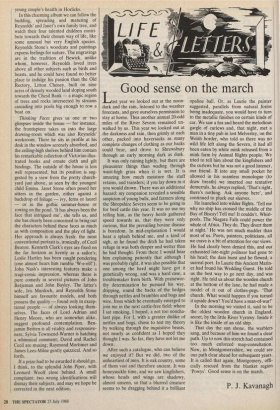Shooting some sitting targets
Frances Partridge
THINKING FACES by Janet Stone
Chatto & Windus, f13, pp. 128
The only self-portrait Janet Stone in- cludes in her fascinating collection takes the form of an informal conversation with her son-in-law, Jonathan Gili. She must be one of very few people who can boast of three bishops in her immediate family (her father and two brothers, one of them bearing the splendid title of 'Primate of All Australia'), but it would be wrong to deduce from this that her home life was austere or formal. It seems rather to have tended towards eccentricity, while a haze of vagueness shrouds the figure of her adored mother, and indeed nearly proved fatal to little Janet: at the age of one month she was packed in a basket with a lid and entrusted to a railway porter somewhere on the way between Cromer and Davos, and most luckily found under the seat of the train, fast asleep. The six Woods children followed their father's disting- uished career from Cambridge to Croydon; by the time he was Bishop of Lichfield Janet had decided to be a singer. She trained at the Royal College of Music, and was afterwards offered free tuition by a well-known Italian teacher who foretold a future for her high dear soprano in Verdi opera. But by now she had met Reynolds Stone the artist, and when he presented himself to her parents they drank the young couple's health in Horlicks.
In this charming album we can follow the budding, spreading and maturing of Reynolds' and Janet's own family tree, and watch their four talented children contri- bute towards their chosen way of life, like some unusual but very English species. Reynolds Stone's woodcuts and paintings express feelings for nature. The engravings are in the tradition of Bewick, unlike whom, however, Reynolds loved trees above all other subjects such as birds and beasts, and he could have found no better place to indulge his passion than the Old Rectory, Litton Cheney, built on nine acres of densely wooded land sloping south towards the Chesil Bank — a magic region of trees and rocks intersected by streams cascading into pools big enough to row a boat on.
Thinking Faces gives us one or two glimpses inside the house — for instance, the frontispiece takes us into the large drawing-room which was also Reynolds' workroom. There he sits in profile at his desk in the window serenely absorbed, and the ceiling-high shelves behind him contain his remarkable collection of Victorian illus- trated books and ornate cloth and gilt bindings. The outside of the house is less well represented, but its position is sug- gested by a view from the pretty church- yard just above, as seen by the youngest child Emma. Janet Stone often posed her sitters in the garden, either against a backdrop of foliage — ivy, ferns or laurel — or in the gothic summer-house or rowing on the pond. 'It has always been the face that intrigued me', she tells us, and she has clearly been concerned to bring out the characters behind these faces as much as with composition and the play of light. Her approach is always fresh: the most conventional portrait is, ironically, of Cecil Beaton. Kenneth Clark's eyes are fixed on the far horizon as keenly as a sailor's; Leslie Hartley has been caught pondering (one almost hears him rumble W-e-ell!'); John Nash's interesting features make a tragi-comic impression, whereas there is pure comedy in several pictures of John Betjeman and John Bayley. The latter's wife, Iris Murdoch, and Reynolds Stone himself are favourite models, and both possess the quality — found only in excep- tional people — of always looking them- selves. The faces of Lord Adrian and Henry Moore, who are somewhat alike, suggest profound contemplation. Ben- jamin Britten is all vitality and responsive- ness; Sylvia Townsend-Warner is hatching a whimsical comment; David and Rachel Cecil are musing; Raymond Mortimer and James Lees-Milne gently quizzical. And so forth.
If a prize had to be awarded it should go, I think, to the splendid John Piper, with Leonard Woolf close behind. A small complaint: two wrong identifications will dismay their subjects, and may we hope be corrected in the next edition.















































 Previous page
Previous page